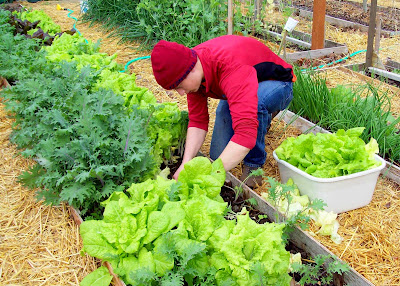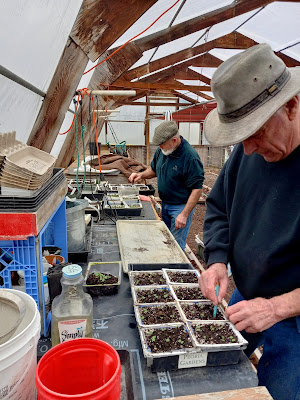We
often start lettuce plants in egg cartons! The egg cartons use less soil per plant than your typical nursery 'six-packs' and when it's time to transplant the seedlings, we just tear off a cell and plant them directly in their permanent bed; egg carton and all! The roots grow right through and have very little transplant shock. We love that the cartons are biodegradable so we're using less plastic in the gardens. Also, they're free!
Here's a step-by-step post on how we do it.
Here's a step-by-step post on how we do it.
 |
| When it's time to
plant the 'starts' in the ground, we remove the 'lid' of the egg
carton that had become the tray that held the egg carton cells while the
lettuce plants were growing. This can be composted. Then we just tear
off each cell and plant
directly. Roots grow right through! (You can see little, tiny roots
coming through the bottom of the egg carton |
 |
| Use finely-sifted potting soil so the seeds don't need to struggle to germinate. Pack it firmly and evenly (with the bottom of another tofu container) so the seeds are started on a flat surface and all come up at the same time. Water the soil. Don't plant too thickly and aim for an even distribution of seeds. This will make it easier to tease them apart and transplant them to the egg cartons later. Sprinkle a very light dusting of soil on top and press it down so seeds have good contact with the soil. Put the tofu containers in a tray and water from the bottom (so the moisture 'wicks' up until the first leaves appear. Watering from the top can make the seeds spread unevenly. Don't over-water! Seeds need very little moisture to get started. |
 |
| Once seedlings are about two inches tall, tease them apart and replant in the egg cartons, one plant per cell. It is important to handle seedlings by the stem, or leaf. Some of their root-hairs are almost too small to see with the naked eye and are easily damaged. (Pic: cabbage seedlings) |
 |
| Tear the lids off the egg cartons and use them as trays under the egg cells. Strip off any labels with thick ink (they don't allow the water to drain well). Soak the egg cartons in a tub of water so they are saturated. Fill each cell with sifted, moist soil. Your seedlings will experience less shock if transplanted into moist soil. Gently water them in with a watering can or fine spray. Keep them in a shady spot for a few days while they get acclimatized. The egg cartons hold moisture while the plants' roots are developing. |
 |
| Before
planting the seedlings, we make a furrow in the soil and water it
thoroughly. This means that the plants are going into wet soil (which
makes them very happy) and, with each subsequent watering, the water is
channeled towards the roots. In the picture above, the black nursery trays (behind the lettuce starts) are covering other recently transplanted lettuce. This shades them to minimize transplant-shock and discourages birds from coming in and helping themselves to spring-time 'salad'. After 4-7 days, we can usually remove the trays without a problem. |
 |
| Many weeks later... |
 |
| It's fun to mix colors/types of lettuce... |
 |
| Lettuce heads are harvested once they reach full size. Here, a Service Learning student harvests Slo-Bolt lettuce for us to share. |
 |
| Now, that's some beautiful lettuce! |






Fascinating post and beautiful photos. Thank you so much for sharing, and warm greetings from Montreal, Canada.
ReplyDeleteBright, joyous blessings to you and your circles...'Bee' well!
Delete